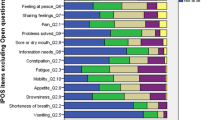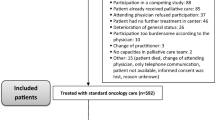Abstract
Purpose
The aim of this study was to compare symptom expression in advanced cancer patients with depression and anxiety and in patients with no such symptoms.
Methods
Secondary analysis of a previous study assessing the role of an acute palliative supportive care unit (APSCU) in a comprehensive cancer center. Patients completed the Edmonton Symptom Assessment System (ESAS) at admission (T0) and 7 days after or at discharge (T7).
Results
Three hundred-fourteen consecutive cancer patients admitted to the APSCU were surveyed. Eighty-six and 66 patients improved their level of depression and anxiety, respectively (passing from ≥ 4 to 0–3, from T0 to T7), after that palliative care intervention resulted in a significant improvement of the other symptoms. Changes were statistically significant for both symptoms (P < 0.0005). Patients admitted for uncontrolled pain were more likely to be anxious, while patients admitted for other symptoms or end-of-life care were more likely to be depressed. The presence of anxiety and depression (≥ 4/10 on ESAS) was significantly associated with a higher level of symptom expression at admission and at T7 (P < 0.0005). In patients presenting both psychological symptoms, symptom expression was significantly more relevant in comparison with patients not reporting moderate-severe psychological symptoms. Pain and depression were independently associated with anxiety at T0. Variables independently associated with depression at T0 were drowsiness, appetite, and anxiety.
Conclusions
Psychological symptoms of ESAS concur to hyper-express some symptoms and make symptom control more difficult. A clear association between anxiety and depression exists.
Similar content being viewed by others
References
Lloyd-Williams M, Shiels C, Taylor F, Dennis M (2009) Depression--an independent predictor of early death in patients with advanced cancer. J Affect Disord 113:127–132
Lo C, Zimmermann C, Rydall A, Walsh A, Jones JM, Moore MJ, Shepherd FA, Gagliese L, Rodin G (2010) Longitudinal study of depressive symptoms in patients with metastatic gastrointestinal and lung cancer. J Clin Oncol 28:3084–3089
Cheung WY, Barmala N, Zarinehbaf S, Rodin G, le LW, Zimmermann C (2009) The association of physical and psychological symptom burden with time to death among palliative cancer outpatients. J Pain Symptom Manag 37:297–304
Ciaramella A, Poli P (2001) Assessment of depression among cancer patients: the role of pain, cancer type and treatment. Psychooncology 10:156–165
Chochinov HM, Wilson KG, Enns M, Lander S (1997) “Are you depressed?” screening for depression in the terminally ill. Am J Psychiatry 154:674–676
Katon W, Lin EHB, Kroenke K (2007) The association of depression and anxiety with medical symptom burden in patients with chronic medical illness. Gen Hosp Psychiatry 29:147–155
Kroenke K, Rosmalen JGM (2006) Symptoms, syndromes, and the value of psychiatric diagnostics in patients who have functional somatic disorders. Med Clin North Am 90:603–626
O'Connor M, Weir J, Butcher I et al (2012) Pain in patients attending a specialist cancer service: prevalence and association with emotional distress. J Pain Symptom Manag 43:29–38
Brown LF, Kroenke K (2009) Cancer-related fatigue and its associations with depression and anxiety: a systematic review. Psychosomatics 50:440–447
Zaza C, Baine N (2002) Cancer pain and psychosocial factors:a critical review of the literature. J Pain Symptom Manag 24:526–542
Wasteson E, Brenne E, Higginson IJ, Hotopf M, Lloyd-Williams M, Kaasa S, Loge JH, the European Palliative Care Research Collaborative (EPCRC) (2009) Depression assessment and classification in palliative cancer patients: a systematic literature review. Palliat Med 23:739–753
Fitzgerald P, Lo C, Li M, Gagliese L, Zimmermann C, Rodin G (2015) The relationship between depression and physical symptom burden in advanced cancer. BMJ Support Palliat Care 5:381–388
Teunissen SCCM, de Graeff A, Voest EE, de Haes JCJM (2007) Are anxiety and depressed mood related to physical symptom burden? A study in hospitalized advanced cancer patients. Palliat Med 21:341–346
Delgado-Guay M, Parsons HA, Li Z, Palmer JL, Bruera E (2009) Symptom distress in advanced cancer patients with anxiety and depression in the palliative care setting. Support Care Cancer 17:573–579
Maltoni M, Caraceni A, Brunelli C, Broeckaert B, Christakis N, Eychmueller S, Glare P, Nabal M, Viganò A, Larkin P, de Conno F, Hanks G, Kaasa S, Steering Committee of the European Association for Palliative Care (2005) Prognostic factors in advanced cancer patients: evidence-based clinical recommendations- a study by the Steering Committee of the European Association for Palliative Care. J Clin Oncol 23:6240–6248
Austin P, Wiley S, McEvoy PM, Archer L (2011) Depression and anxiety in palliative care inpatients compared with those receiving palliative care at home. Palliat Support Care 9:393–400
Mercadante S, Adile C, Caruselli A, Ferrera P, Costanzi A, Marchetti P, Casuccio A (2016) The palliative-supportive care unit in a Comprehensive Cancer Center as crossroad for patients’ oncological pathway. PLoS One 11:e0157300
Bruera E, Kuehn N, Miller MJ, Selmser P, Macmillan K (1991) The Edmonton Symptom Assessment System (ESAS): a simple method for the assessment of palliative care patients. J Palliat Care 7:6–9
Hui D, Bruera E (2017) The Edmonton Symptom Assessment Scale remains useful for depression screening. Palliat Med 31:483–484
Chang VT, Hwang SS, Feuerman M (2000) Validation of the Edmonton Symptom Assessment Scale. Cancer 88:2164–2171
Rhondali W, Yennurajalingam S, Ferrer J, Chisholm G, Filbet M, Bruera E (2014) Association between supportive care interventions and patient self-reported depression among advanced cancer outpatients. Support Care Cancer 22:871–879
Ripamonti CI, Bandieri E, Pessi MA, Maruelli A, Buonaccorso L, Miccinesi G (2014) The Edmonton Symptom Assessment System (ESAS) as a screening tool for depression and anxiety in non-advanced patients with solid or haematological malignancies on cure or follow-up. Support Care Cancer 22:783–793
Modonesi C, Scarpi E, Maltoni M, Derni S, Fabbri L, Martini F, Sansoni E, Amadori D (2005) Impact of palliative care unit admission on symptom control evaluated by the Edmonton Symptom Assessment System. J Pain Symptom Manag 30:367–373
Wakefield CE, Butow PN, Aaronson NA, Hack TF, Hulbert-Williams NJ, Jacobsen PB, International Psycho-Oncology Society Research Committee (2015) Patient-reported depression measures in cancer: a meta-review. Lancet Psychiatry 2:635–647
Grotmol KS, Lie HC, Loge JH, Aass N, Haugen DF, Stone PC, Kaasa S, Hjermstad MJ (2018) Patients with advanced cancer and depression report a significantly higher symptom burden than non-depressed patients. Palliat Support Care 10:1–7. https://doi.org/10.1017/S1478951517001183
Zweers D, de Graaf E, de Graeff A et al (2017) The predictive value of symptoms for anxiety in hospice inpatients with advanced cancer. Palliat Support Care 16(5):602–607
Brown LF, Kroenke K, Theobald DE, Wu J, Tu W (2010) The association of depression and anxiety with health-related quality of life in cancer patients with depression and/or pain. Psychooncology 19:734–741
Nipp RD, El-Jawahri A, Moran SM et al (2017) The relationship between physical and psychological symptoms and health care utilization in hospitalized patients with advanced cancer. Cancer 123:4720–4727
Author information
Authors and Affiliations
Corresponding author
Ethics declarations
The study was approved by the ethical committee and informed consent was obtained.
Conflict of interest
All authors declare that they have no conflict of interest.
Additional information
Publisher’s note
Springer Nature remains neutral with regard to jurisdictional claims in published maps and institutional affiliations.
Rights and permissions
About this article
Cite this article
Mercadante, S., Adile, C., Ferrera, P. et al. Symptom hyper-expression in advanced cancer patients with anxiety and depression admitted to an acute supportive/palliative care unit. Support Care Cancer 27, 3081–3088 (2019). https://doi.org/10.1007/s00520-018-4624-0
Received:
Accepted:
Published:
Issue Date:
DOI: https://doi.org/10.1007/s00520-018-4624-0




